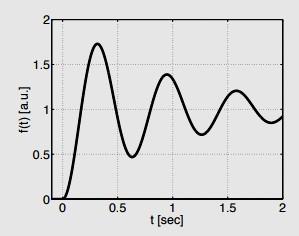
1. A second–order system has the step response shown below.1 Determine its transfer function


Answer: This is under–damped 2nd order system. Starting from the transfer function of the second order system we have to decide the parameters of A(constant),ζ(damping ratio) and ωn(natural frequency). From the final value theorem, and the steady state value is 1 (from the given figure). Therefore, A = 1. The step response of the under–damped second order system is


1 − ae σdt cos (ωdt − φ) u(t), where σ 2 d = ζωn and ωd = ωn √ 1 − ζ .
From the lecture note 7 (pp. 26), %OS = exp (− ζπ /1−ζ 2) :72% Thus the damping ratio ζ ≈ 0.1
To get the natural frequency, we choose two peak points at t1 = 0.35 sec and t2 = 0.95 sec. The cosine term will be 1 at the peaks, so that we can consider exponential decay term only

f(t1) = 1 − ae−σdt1 = 1.72 f(t2) = 1 − ae−σdt2 = 1.4 Dividing the two equations, we obtain

From that σ d = {ln (0.72/0.4)} / {t2 = t1 } = 0.9796. Therefore ωn ≈ 9.8. (The reason why I picked two points instead of one point is to cancel the constant a). The transfer function is

Note that the estimated parameters might be slightly different than the original because our reading of the plot can never be completely accurate. 2. Consider a pendulum and inverted pendulum, as shown in the figure below. In this problem we will explore how they are different physically, and how the difference is mapped out in the Laplace domain. We assume that the mass m and length l are the same in both cases, and that they are both subject to viscous friction with coefficient b from the surrounding medium (in reality, the pendulums would be subject to drag forces as well, but we neglect them here to simplify the problem.) In both cases, the pendulums are driven by a force r(t) applied in the direction tangential to the motion. The initial conditions are θ(0) = 0 and ˙θ(0) = 0.


2.a) Derive the equations of motion for the two cases, using the angle θ(t) as the output variable, and assuming small motion |θ| 1 away from the vertical.



Answer: We begin with the free–body diagrams (FBDs) for the two cases, shown respectively above as well. For the standard pendulum (left–hand side) torque balance from the FBD in conjunction with Newton’s law of motion yield
ml2 ¨θ(t) = r(t)l − mglsin θ(t) − Ffrictionl. (1)

Substituting for viscous friction F ˙ friction = bθ(t), and dividing across by ml2 we obtain the equation of motion (2)
Assuming that the pendulum never strays too far away from the vertical, |θ| 1, therefore sin θ ≈ 1 and the linearized equation of motion becomes (3)
Following similar procedure in the case of the inverted pendulum (right– hand side in the above figure) torque balance yields
ml2 ¨θ(t) = r(t) + mglsin θ(t) − Ffrictionl. (4) from which we obtain the liberalized equation of motion as (5)



Comparing (5) and (3), we can see that there is only a difference in sign compared to the standard pendulum case. However, we will see that this difference has a profound effect on the system behavior.
b) Derive the transfer function Θ(s)/R(s) for the two cases, and draw the locations of any poles and zeros that you find on the complex (s–) plane.
Answer: Starting with the standard pendulum, Laplace transforming both sides of (3) and taking into account the zero initial conditions, we obtain
From this we conclude that there are no zeros in the transfer function, and there are two poles located at



Under normal conditions, we expect friction to be weak, certainly so that the friction coefficient satisfies b < 2m √ gl. Then the two poles become complex, with real part

Matching the coefficients of the polynomial in the denominator with those of our “standard” 2nd–order system transfer function, we find that for the standard pendulum






In the case of the inverted pendulum, similar procedure yields Again, there are no zeros, and there are two poles located at Unlike the previous case, both poles are now real, and, moreover, the pole located at is positive! This indicates that the impulse, step, etc. responses of the inverted pendulum contain exponentially increasing terms. (You can easily verify the effect of the exponentially increasing term by trying to hold a pen upright on your palm.) It is important to note that, since θ(t) may increase exponentially in this case, the assumption of small |θ| 1 will break down after some time t, and then system behavior won’t be well modeled by our equations.
The locations of the system poles for the standard and inverted pendulum on the complex plane are shown on the left– and right–hand side diagrams below, respectively, on the next page. Note the locations of the poles for the under damped standard pendulum are symmetric with respect to the real axis (i.e., complex conjugates). Also note the location of one pole of the inverted pendulum on the right–hand side of the complex plane. Systems with at least one pole on the right–hand side of the complex plane are called unstable.


